Digital Age
This chapter covers the invention of computers and software, the development of digital media as they replaced analog equivalents during the last decades of the 20th century, and the invention and evolution of the Internet.
TOPICS
• Computers: Early and mechanical, electronic, microprocessors, PCs
• Founding or Microsoft and Apple, Apple I and II, first IBM PC
• Graphical User Interface, Macintosh 128K
• Key components, mechanical and optical mice
• PC vs Mac: Microsoft and Apple history
• Media: Mesopotamia, Egypt, China
• Steve Jobs and Bill Gates biographies
• Digital progress: Moore’s Law
• Data storage: hard drives, SSDs
• Displays: LCD, LED screens
• Touchscreen mobile devices: smartphones
• Digital data: Software, memory, interfaces, programming languages
• Analog to digital: Audio, text, design, photos and video, movies
• The Internet: Origin, ARPANET, BBS’s, HTML and the Web, Web browsers
• Internet hardware
• The digital transformation
• 1977 Apple logo
• Macintosh 128K
• Macintosh 128K key components
• Motherboard
• Mouse - 2 panels
• Number of transistors 1970-2020
• Hard drive/SSD
• Touchscreens
• LCD screen
• Touchscreen smartphones
• Analog to digital audio
• Digital cameras
• HTML
• Using the Internet
• Internet usage worldwide 2001-2019
• Internet use by regions 2019
• Facebook users 2008-2019
• Antikythera mechanism
• Altair 8800 computer
• Apple I
• Apple II
• Steve Jobs portrait
• Bill Gates portrait
• LCD watch
• Claude Shannon portrait
• Punchcard
• Ada Lovelace portrait
• 1984 Sony Discman D50
• 1997 MPMan MP3 player
• 2001 Apple iPod MP3 player
• First digital scan of photo
• BBS interface
• Tim Berners-Lee portrait
There were three developments that dramatically changed communication by the end of the 20th century: personal computers, digitized data, and the Internet.
Computers weren’t intended to be communication machines. Their original purpose was no more complicated than their name, which was to compute, to perform intricate mathematical calculations that were difficult and time consuming. And that’s all they were used for at first. But as they became compact and affordable enough for business use and for the general public, they gained capabilities in processing and displaying text, audio and video.
As electronics became ubiquitous in the second half of the 20th century, the way that information was recorded and stored was changed from analog to digital. This gradually happened to all forms of information, including text, audio, photography and video, which changed the way that information was created and then broadcast or transmitted over fiber optic networks.
And then came the Internet, which connected computers with each other no matter where they were in the world, and allowed users to send messages and content to each other.
In the last decade of the century the World Wide Web came into existence, and began to disrupt the systems by which every type of content—text, images, audio, video, movies—was distributed.
The result of these developments has been dramatic. In the first two decades of the 21st century, the Web has changed the way we communicate, with profound social, economic and political effects.
Pre-digital
Design Before Computers Ruled the Universe. Speider Schneider, webdesignerdepot.com, Feb. 29, 2012.
Babbage
Who was Charles Babbage? Charles Babbage Institute, U. of Minnesota.
The Babbage Engine. Computer History Museum, Mountain View, CA.
What a Difference the Difference Engine Made: From Charles Babbage’s Calculator Emerged Today’s Computer. Edwards Park, Smithsonian Magazine, Feb. 1996.
Computers
How Computers Work: The Evolution of Technology, 10th Edition. Ron White, Que Publishing 2014.
Bletchley Park. The National Museum of Computing, bletchleypark.org.uk.
The IBM Automatic Sequence Controlled Calculator. Columbia University, columbia.edu.
The Computer Museum. Maryland Technology Museum, Hunt Valley, MD.
Computer History Museum. Mountain View, CA.
Computer monitor history. computerhope.com, April 2, 2019.
Micro Instrumentation and Telemetry Systems. wikipedia.org.
A brief history of computers. Chris Woodford, explainthatstuff.com, Mar. 21, 2020.
How Do Computers Work? Jordan Semler, factmyth.com, May 26, 2016.
How Computers Work: The CPU and Memory. Department of Computer Science and Statistics, The University of Rhode Island.
IBM's ASCC introduction (a.k.a. The Harvard Mark I). ibm.com.
Personal Computer History: 1975-1984. Daniel Knight, lowendmac.com, Apr. 26, 2014.
Osborne 1 - 1981.First “portable” computer. oldcomputers.net.
Konrad Zuse (1910-1995). Builder of Z3, first programmable computer. Jürgen Schmidhuber, people.idsia.ch.
Gottfried Wilhelm Leibniz. (1646–1716). Mathematician and philosopher: Concept of binary code; inventor of square root calculator. Stanford Encyclopedia of Philosophy, July 24, 2013.
The US Again Has the World’s Most Powerful Supercomputer. Tom Simonite, wired.com, June 8, 2018.
Xerox PARC
Timeline: PARC milestones. Todd R. Weiss, computerworld.com, Sept. 20, 2010.
ICL PERQ 2 T1 Workstation. The Centre for Computing History, Cambridge, England.
Xerox PARC. parc.com.
Graphical User Interface (GUI)
A History of the GUI. Jeremy Reimer, arstechnica.com, May 5, 2005.
Sketchpad—Complete History of the Sketchpad Computer Program. history-computer.com.
CPU chip
ARM PRocessor Evolution: Briinging High Performance to Mobile Devices. Simon Segars EVP and GM, ARM 2011.
It’s Time to Get Excited About the Future of PCs. (Yes, PCs). Brian Barrett, wired.com, June 9, 2010.
Mouse
Creating the First Usable Mouse. ideo.com.
Complete History of The Computer Mouse. history-computer.com.
How the Guy Who Designed 1 of Apple’s Most Iconic Products Organizes His Office. Betsy Mikel, inc.com, Jan. 24, 2018.
the Engineer of the Original Apple Mouse Talks About his Career. Kyle Vanhemert, wired.com, Aug. 10, 2014.
First video game
The Best Video Game the Year You Were Born. Popular Mechanics, Nov. 30, 2019.
The First Video Game. theawesomer.com, Oct. 4, 2019.
Apple
Apple. fortune.com.
The complete history of Apple’s iPod. Nate Lanxon, Andrew Hoyle, cnet.com, Oct. 24, 2011.
History of the iPod: From the First iPod to the iPod Classic. Sam Costello, lifewire.com, Jan. 12, 2020.
The iPod: How Apple’s legendary portable music player came to be. Benj Edwards, MacWorld, Oct. 22, 2011.
History of Apple: The story of Steve Jobs and the company he founded. Nik Rawlinson, MacWorld, April 25, 2017.
iTunes Is Dead. Let’s Pay Our Respects. Brian Barrett, wired.com, June 3, 2019.
Macintosh
Falling in love with the Macintosh 128K back in 1984. Ben Lovejoy, 9to5mac.com, Jan. 24, 2014.
The Macintosh turns 30: Going the distance. Dan Farber, cnet.com, Jan. 21, 2014.
Apple’s original Mac can fetch $1,598 on eBay. Donna Tam, cnet.com, Jan. 22, 2014.
Apple Macintosh Original (128k) Specs. everymac.com.
Macintosh 128K Teardown. ifixit.com.
2013’s Mac Pro vs. 1984’s Macintosh 128K. Lucy Hattersley, MacWorld, Feb. 13, 2015.
Apple Macintosh Plus microcomputer (1MByte RAM) — 1986. Newcastle University History of Computing Artefact Collection.
Macintosh 128K: Technical Specifications. apple.com.
IBM
The birth of the IBM PC. ibm.com.
Microsoft
Microsoft. fortune.com.
A Short History of Microsoft. Mary Bellis, thoughtco.com, Jan. 10, 2020.
The history of Microsoft Word. Lucy Wright, core.co.uk, March 5, 2019.
Windows
Microsoft Windows history. computerhope.com, Nov. 16, 2019.
From Windows 1 to Windows 10: 29 years of Windows evolution. Samuel Gibbs, The Guardian, Oct. 2, 2014.
Revisiting Windows 1.0: how Microsoft’’s first desktop gracefully failed. Sean Hollister, theverge.com, Nov. 20, 2012.
Hewlett-Packard
50th Anniversary Of The HP 2116 Minicomputer. Chuck House, Computer History Museum, Nov. 7, 2016.
HP 2100. wikipedia.org.
HP: The Accidentally, On-Purpose Computer Company. hp9825.com.
HP 2116. HP Computer Museum.
OS market share
Operating System Market Share. netmarketshare.com.
Computer ownership
Percentage of households with a computer at home in the United States from 1984 to 2010. statista.com.
Moore’s Law
Largest Processor Ever Built Packs 1.2 Trillion Transistors, Leaves Top-End Intel And AMD CPUs and GPUs Behind. Alap Naik Desai, appuals.com, Aug. 10, 2019.
Largest Chip Ever Holds 1.2 Trillion Transistors. Al Williams, hackaday.com, Aug. 21, 2019.
Moore’s Law. Carla Tardi, investopedia.com, Feb. 24, 2021.
42 Years of Microprocessor Trend Data. Karl Rupp, karlrupp.net, Feb. 15, 2018.
Transistor count. wiki2.org.
Transistor size
Tiniest Transistor – Yet: 2.5 Nm. Roberto Saracco, ieee.org, March 13, 2019.
A new material helps transistors become vanishingly small. The Economist, July 18, 2020.
Scientists Have Made Transistors Smaller Than We Thought Possible. Avery Thompson, Popular Mechanics, Oct. 12, 2016.
Hard drive
A History of Hard Drives. Peter Cohen, backblaze.com, Nov. 17, 2016.
Computer hard drive history. computerhope.com, April 12, 2021.
The astounding evolution of the hard drive. Alex Cocilova, PC World, Sept. 12, 2013.
The History Of The Hard Drive. Nigel Harley, thinkcomputers.org.
SSD
Solid-state revolution: in-depth on how SSDs really work. Lee Hutchinson, arstechnica.com, June 4, 2012.
The History of USB Flash Drives. Leo Champion, techwalla.com.
Digital watch
The Digital Watch: A Brief History. Benj Edwards, PC Magazine, Oct. 17, 2018.
Tech Time Warp of the Week: The 1972 Digital Watch That Cost More Than a Car. Klint Finley, wired.com, March 6, 2015.
LCD
Liquid Gold: The Story of Liquid Crystal Displays and the Creation of an Industry. Joseph A. Castellano, World Scientific Publishing Company 2005.
LED vs. LCD: which is better? Philip Wong, cnet.com, July 6, 2011.
LED vs. LCD TVs explained: What’s the difference? Quentyn Kennemer and Ryan Waniata, digitaltrends.com, Feb. 7, 2021.
Liquid-crystal display. wikipedia.org.
File:Lcd-engineerguy.ogv. wikipedia.org.
Milestones:Sharp 14-inch Thin-Film-Transistor Liquid-Crystal Display (TFT-LCD) for TV, 1988. ethw.org, Dec. 31, 2015.
Touchscreen
Capacitive Sensing Made Easy, Part 1: An Introduction to Different Capacitive Sensing Technologies. Pushek Madaan and Priyadeep Kaur, Cypress Semiconductor Corp. 2012.
The History Of The Tablet, An Idea Steve Jobs Stole And Turned Into A Game-Changer. Julie Bort, businessinsider.com, Jun 2, 2013.
How the iPhone Works. Tracy V. Wilson, Nathan Chandler, Wesley Fenlon & Bernadette Johnson, howstuffworks.com.
Touchscreens, large and small. Binay Bajaj, electronicproducts.com, Oct. 26, 2011.
Mutual Capacitance vs Self-Capacitance Touchscreen Technology. en-touch.com, Sept. 19, 2017.
Single-Touch vs Multi-Touch: What’s the Difference? en-touch.com, May 24, 2016.
Apple Newton. wikipedia.org.
PLATO (computer system). wikipedia.org.
How Touch Screen Monitors Work. lorextechnology.com, April 19, 2012.
Touch Technology Brief: Projected Capacitive Technology. 3M Touch Systems, 3M Company 2013.
How Touch Screen Monitors Work. Mat Honan, wired.com, Aug. 5, 2013.
Touchscreen
The world’s first smartphone, Simon, was created 15 years before the iPhone. Steven Tweedie, businessinsider.com, June 14, 2015.
First Smartphone Turns 20: Fun Facts About Simon. Doug Aamoth, Time Magazine, Aug. 18, 2014.
Under the Hood: The iPhone’s Gaming Mettle. Blake Patterson, toucharcade.com, Feb. 1, 2011.
Smartphone usage
Apple hits 1.5 billion active devices with ~80% of recent iPhones and iPads running iOS 13. Michael Potuck, 9to5mac.com, Jan. 28, 2020.
Mobile Operating System Market Share Worldwide. statcounter.com.
Global smartphone market share from 4th quarter 2009 to 1st quarter 2021. statista.com.
Apple says there are 1.4 billion active Apple devices. Dami Lee, theverge.com, Jan. 29, 2019.
Digital data
Google Celebrates 100th Birthday of Claude Shannon, the Inventor of the Bit. David Z. Morris, fortune.com, April 30, 2016.
Profile of Claude Shannon, Inventor of Information Theory. John Horgan, Scientific American, July 26, 2017.
Binary Alphabet: The Alphabet Letters in Binary. convertbinary.com.
Number Bases: Introduction ’ Binary Numbers. purplemath.com.
ASCII History. wikidot.com.
1963: First edition of the ASCII standard was published. computinghistory.org.
Difference Between Unicode and ASCII. differencebetween.net.
ASCII. ethw.org.
ASCII (American Standard Code for Information Interchange) is Promulgated. historyofinformation.com.
What exactly IS an API? Perry Eising, medium.com, Dec 7, 2017.
What is an API? (Application Programming Interface). mulesoft.com.
Programming
The Mathematical Theory of Communication. Claude E. Shannon, Warren Weaver, University of Illinois Press 1998.
Punch card. computerhope.com, May 2, 2021.
Women in programming
14 world-changing innovations by women that were originally credited to men. Melina Glusac, insider.com, March 8, 2020.
Ada Lovelace, the First Tech Visionary. Betsy Morais, The New Yorker, Oct. 15, 3013.
Katherine Johnson, NASA Mathematician And An Inspiration For 'Hidden Figures,' Dies. Russell Lewis, npr.org, Feb. 24, 2020.
Jean Sammet, Co-Designer of a Pioneering Computer Language, Dies at 89. Steve Lohr, The New York Times, June 4, 2017.
Digital audio
Analog vs Digital Audio: What’s the Difference? adorama.com, Dec. 17, 2018.
Which Sounds Better, Analog or Digital Music? Katrina Morgan, Scientific American, Oct. 11, 2017.
Becoming Digital: Audio and Moving Images. Excerpt from Digital History: A Guide to Gathering, Preserving, and Presenting the Past on the Web, by Daniel Cohen and Roy Rosenzweig, Dept. of History and Art History at George Mason University, Oct. 11, 2017.
Digital camera
A Comprehensive Beginner’s Guide to Photography, Second Edition. Scott G. Shelp, Selective Focus Press 2006.
How Digital Cameras Work. Jerry Lodriguss, astropix.com.
CCD (Image Sensor) Design. panasonic.com.
CMOS. wikipedia.org.
Webcams. Chris Woodford, explainthatstuff.com, Sept. 30, 2020.
Back in 1991, NASA Sent a Hacked Nikon F3 with a Kodak Digital Back into Space. Chris Woodford, thephoblographer.com, April 17, 2014.
Understanding The Digital Image Sensor. thinklucid.com.
The History of the Digital Camera. Mary Bellis, thoughtco.com, March 29, 2020.
Digital photography in 1991 (photos). Janice Chen, zdnet.com, April 17, 2011.
Word processor
Tracing the History of the Computer - History of Word Processors. computernostalgia.com.
Digital prepress
The history of prepress. prepressure.com.
Digital design
How QuarkXPress became a mere afterthought in publishing. Dave Girard, arstechnica.com, Jan. 13, 2014.
History of QuarkXPress. ccjk.com.
Adobe Photoshop. wikipedia.org.
Adobe Corporation. Silicon Valley Historical Association.
Scanner
Computer Scanner – History of the Modern Computer Scanner. history-computer.com.
Camera phone
The Camera Phone is 20 Years Old! Allan Weitz, bhphotovideo.com, 2017.
A complete history of the camera phone. Simon Hill, digitaltrends.com, Aug. 11, 2013.
Evolution of the Mobile Phone. tigermobiles.com.
Digital movie
The Triumph of Digital Will Be the Death of Many Movies. Helen Alexander and Rhys Blakely, New Republic, Sept. 12, 2014.
11 Movies that Shaped the Digital Revolution. Sean Hutchinson, mentalfloss.com, March 14, 2014.
CGI
History of computer animation 1950’s-2010’s. computeranimationhistory-cgi.jimdofree.com, Jan. 2018.
The Ultimate History of CGI in Film. Vashi Nedomansky, vashivisuals.com, March 21, 2019.
Quantum computing
This New Chip Could Bridge The Gap Between Classical And Quantum Computing. David Nield, sciencealert.com, Sept. 28. 2019.
Integer factorization using stochastic magnetic tunnel junctions. William A. Borders, Ahmed Z. Pervaiz, Shunsuke Fukami, Kerem Y. Camsari, Hideo Ohno ’ Supriyo Datta, Nature 573, 390–393, Sept. 18. 2019.
The WIRED Guide to Quantum Computing. Tom Simonite, wired.com, Aug. 24. 2018.
INTERNET
Internet history
DARPA (Defense Advanced Research Projects Agency). darpa.mil.
The real history of the modern Internet. Steven Vaughan-Nichols, hpe.com, Jan. 11, 2018.
Brief History of the Internet. Barry M. Leiner, Vinton G. Cerf, David D. Clark, Robert E. Kahn, Leonard Kleinrock, Daniel C. Lynch, Jon Postel, Larry G. Roberts, Stephen Wolff, internetsociety.org, 1997.
How the Web was Won: Tim Berners-Lee and the birth of the World Wide Web. Charles Apple, The Spokesman-Review, June 22, 2020.
How the Internet was born: from the ARPANET to the Internet. Giovanni Navarria, theconversation.com, Nov. 2, 2016.
Tim Berners-Lee
Solid (web decentralization project). wikipedia.org.
Tim Berners-Lee. wikipedia.org.
Tim Berners-Lee. w3.org.
DNS (Domain Name System)
DNS history. When and why was DNS created? Martin Pramatarov, cloudns.net, Dec. 27, 2018.
Domain Name System. wikipedia.org.
URL (Uniform Resource Locator)
The History of the URL. Zack Bloom, cloudflare.com, March 5, 2020.
An Atlas of Cyberspaces. Martin Dodge ’ Rob Kitchin, University of Manchester, Feb. 2007.
Modems
Hayes Microcomputer Products. wikipedia.org.
Modem – Complete History of The Modem. history-computer.com.
History of dial up modems. whirlpool.net.au.
First BBS
The Birth of the BBS. Randy Suess and Ward Christensen, chinet.com, 1989.
CBBS (Computerized Bulletin Board System). wikipedia.org.
The Lost Civilization of Dial-Up Bulletin Board Systems. Benj Edwards, The Atlantic, Nov. 4, 2016.
Browser
A Singular Moment in Time. T. Scott Plutchak, Journal of the Medical Library Association, April 2004
Mozilla Firefox. mozilla.org.
NCSA Mosaic. National Center for Supercomputing Applications, U. of Illinois at Urbana-Champaign.
Mosaic turns 25: The beginning of the modern web. Steven J. Vaughan-Nichols, zdnet.com, April 25, 2018.
The beginning of the people’s Web: 20 years of Netscape. Steven J. Vaughan-Nichols, zdnet.com, Oct. 14, 2014.
User data
World Internet Users and 2021 Population Stats. internetworldstats.com.
Top 20 Countries With The Highest Number Of Internet Users. internetworldstats.com.
Statistics. International Telecommunication Union.
World Telecommunication/ICT Development Report 2010 - Monitoring the WSIS targets. International Telecommunication Union.
Internet usage worldwide - Statistics ’ Facts. Joseph Johnson, statista.com.
Number of broadband internet subscribers in the United States from 2011 to 2020, by cable provider. S. O'Dea, statista.com, Apr 8, 2021.
Number of monthly active Facebook users worldwide as of 1st quarter 2021. H. Tankovska, statista.com, May 21, 2021.
Most popular social networks worldwide as of April 2021, ranked by number of active users. H. Tankovska, statista.com, June 29, 2021.
Utilisateurs d Internet (% de la population). La Banque Mondiale.
Cable
History of Cable. California Cable & Telecommunications Association.
Internet access. wikipedia.org.
Websites
Giants of the Web. Charles Apple, The Spokesman-Review, April 23, 2020.
Online newspapers
A Brief History of Digital News. Josh Sanburn, Time Magazine, Feb. 01, 2011.
New Media Timeline (1980). David Shedden, poynter.org, Dec. 16, 2004.
Today in media history: CompuServe and the first online newspapers. David Shedden, poynter.org, Sept. 24, 2014.
Twitter thread: Media Layoffs. Jeremy Littau, twitter.com, Jan. 24, 2019.
NOTE: Weblinks were current and active at the time of the last update to the site, but may have since become unavailable or outdated. If you encounter a dead link, please notify me at phil.loubere@mtsu.edu. Thanks.
Last update: June 2021
Content related to this chapter’s topics will be periodically posted here.
The Internet
The Internet started in the early 1960s as a project called Arpanet, largely funded by the US military. The first successful transmission of data happened in 1969, between connected computers, called nodes, at four research universities on the West Coast of the US: Stanford, UC Santa Barbara, UCLA, and the University of Utah.
Arpanet officially ceased to exist in 1990 when the Internet became accessible to the general public, which was the same year that Tim Berners-Lee published the HTML programming language, marking the beginning of the World Wide Web.
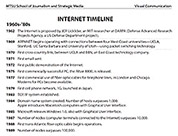
Internet timeline-PDF
Downloadable PDF with key dates from 1962 to present:
internet_timeline.2021.pdf
Here is a PDF about the start of the Internet:
ISOC-History-of-the-Internet_1997.pdf
Logic and Philosophy
Computer software relies on concepts originally proposed by a succession of philosophers going back to Aristotle (often cited as 'the inventor of logic'). As an example, Aristotle’s most famous argument was: “All men are mortal; Socrates is a man, therefore Socrates is mortal”. This true or false logical structure is the basis for typical code, which employs what is called Boolean logic, for example: If condition x is true, then perform function a, otherwise perform function b. (George Boole was a 19th century mathematician who first proposed these concepts in his 1847 book The Mathematical Analysis of Logic).
This logic is evident in the work of the two most important figures in developing digital technology, Claude Shannon and Alan Turing. Shannon even cites Aristotle in his thesis.
Here are a couple articles that explain this more fully:

How Aristotle Created The Computer. Chris Dixon, The Atlantic, March 20, 2017.
This article follows the path of logical propositions starting with Aristotle and going through 19th century philosophers who pursued 'mathematical logic', work that provided the logical framework used by Shannon and Turing.

Pi Day: How One Irrational Number Made Us Modern. Steven Strogatz, The New York Times, March 14, 2019.
In this article, the author argues that the way we use digital data to record information was only made possible by Archimedes’ method of calculating the value of pi, about 2,300 years ago.
Here are the original papers of Shannon and Turing that are considered foundational documents of modern computing.
A Symbolic Analysis of Relay and Switching Circuits. Claude Shannon, Massachusetts Institute of Technology 1937. Downloadable PDF.
On Computable Numbers, with an Application to the Entscheidungsproblem. Alan Turing, Proceedings of the London Mathematical Society, Volume s2-42, Issue 1, 1937, Pages 230–265.
Chip design innovator

Lynn Conway ncwit.org.
An important figure in the early design and production of microchips, she was fired from her first job at IBM in 1968 for undergoing gender transition. In the 1970s she worked at Xerox PARC, where she invented scalable rules for chip design, which led to a revolution in chip capabilities in the 1980s, a crucial factor in the development of personal computers. She was principle author of the definitive text on the subject.
The first search engine
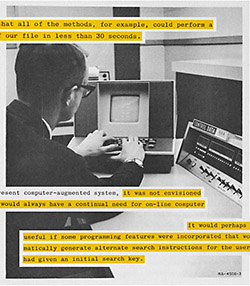
When Was the Earliest Internet Search? April White, Smithsonian Magazine, Sept. 2018.
Years before the birth of Google, a forgotten experiment laid the groundwork for the ubiquitous search engine.
Email in 1984

How to check your email in 1984. Jon Erlichman, twitter.com, May 16, 2021.
Computer Animation
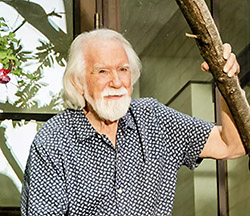
The Little-Known Genius Who Helped Make Pixar Possible. Steven Levy, Wired Magazine, Aug. 31, 2021.
Alvy Ray Smith was the co-founder of Pixar and was a key figure in the early development of computer graphics. Without his work applications such as Photoshop wouldn’t have been possible.
Moore’s Law

The $150 Million Machine Keeping Moore’s Law Alive. Will Knight, Wired Magazine, Aug. 30, 2021.
ASML’s next-generation extreme ultraviolet lithography machines achieve previously unattainable levels of precision, which means chips can keep shrinking for years to come.
Superconductors
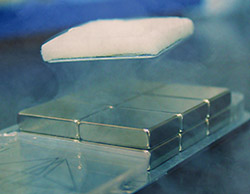
The Technology That Will Change Everything. Ella Alderson, medium.com, Nov. 16, 2020.
Conductors such as copper wires lose a substantial portion of energy to heat. This is why your computer needs fans to cool it, and which also limits its processing power. Superconductors are materials that don't lose any energy when electricity passes through them. But the ones we know of only work at either extremely low temperatures, close to absolute zero, or under extreme pressure.
The search is on for superconductors that will work at room temperature and at normal atmospheric pressure. If they can be developed, then everything powered by electricity will work much more efficiently. Computers could be significantly more powerful without any cooling needed. Some believe it’s not a question of if but of when.
Quantum Computing
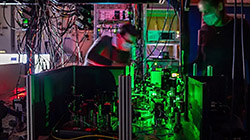
World’s 1st multinode quantum network is a breakthrough for the quantum internet. Ben Turner, livescience.com, May 3, 2021.
You probably need to be a physics scientist in order to understand quantum computing. But the science behind it could be a way to make vastly more powerful computers.
The basic premise is to use units called qubits in the same way that bits are used in binary code. Just as bits can be either one or zero, so can qubits, but in the strange world of quantum mechanics a qubit can be both one and zero at the same time up to the point it is measured, when it will be either one or zero.
This fluid state allows qubits to perform multiple calculations simultaneously, which has the potential to make computers and networks much faster.
Digital Assistants
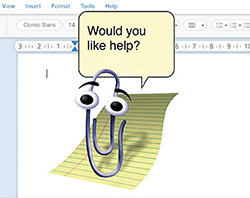
Clippy. Benjamin Cassidy, seattlemet.com, Aug. 23, 2022.
Clippy was an early attempt by Microsoft to provide assistance to people new to computers.
In the mid 1990s few people owned a PC. User testing revealed that people were confused and intimidated by software interfaces. Microsoft tried to solve this problem with an animated paperclip that would pop up and offer assistance. But it became an object of derision, a cultural meme that persists to this day.
Now, however, Clippy seems to have become a nostalgic figure. Microsoft is showcasing it again.
Last update: September 2022




